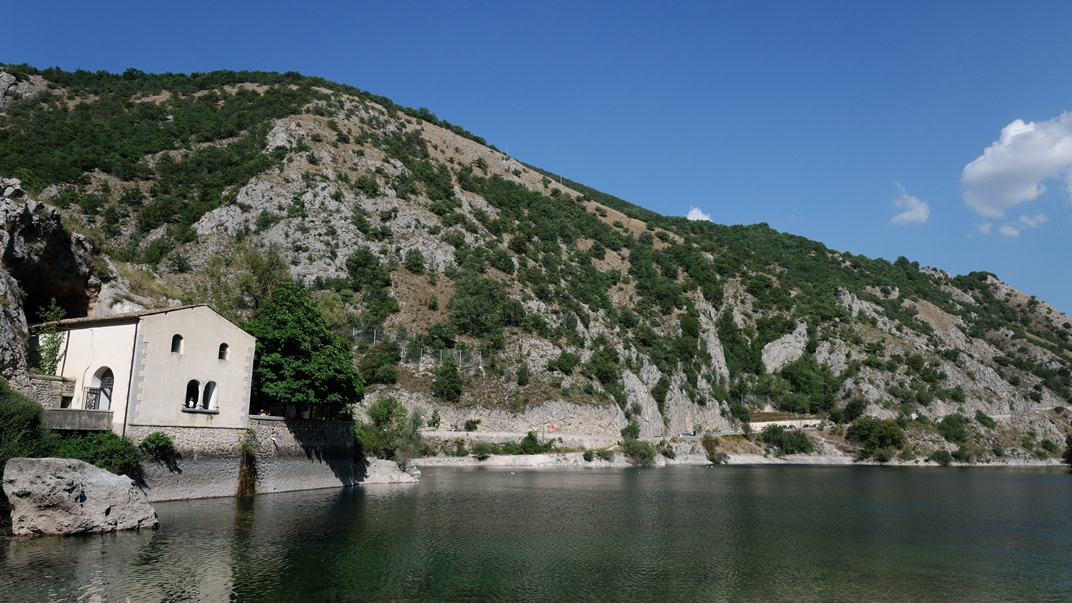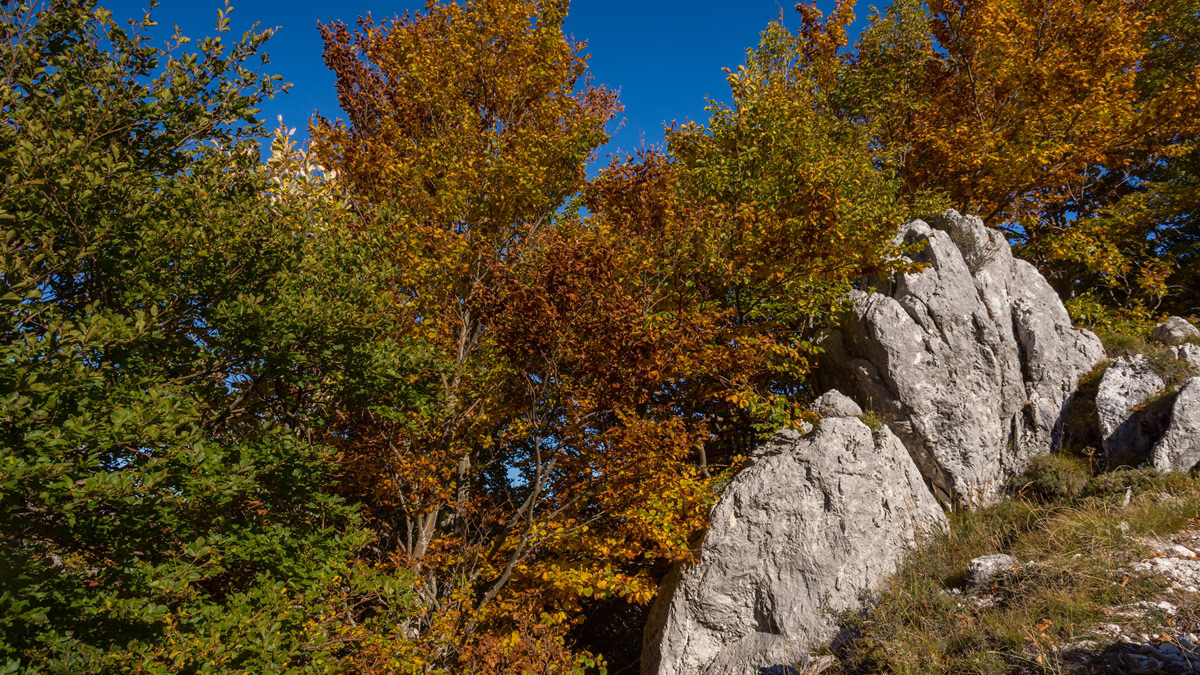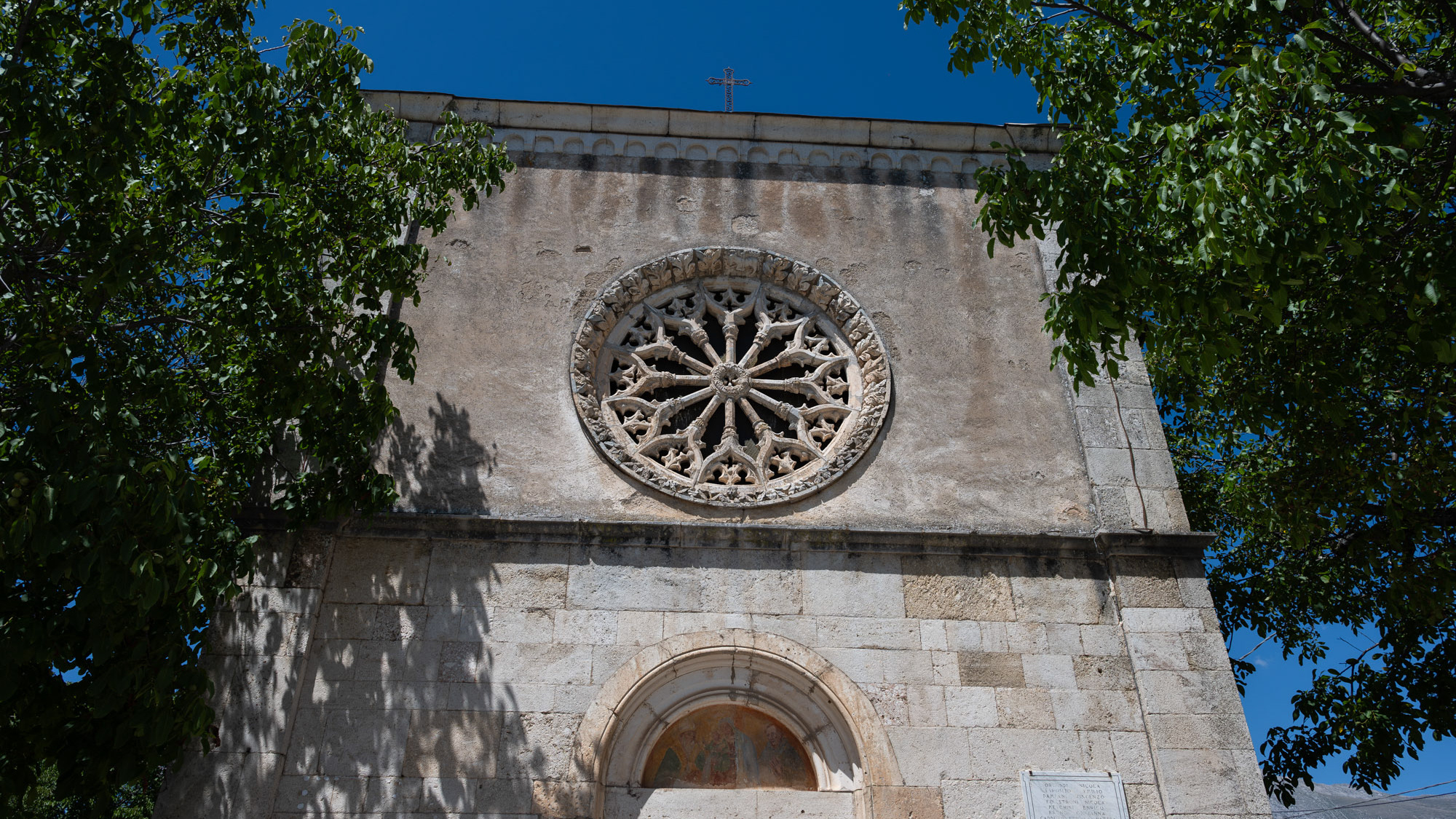Ortona. Basilica of St. Thomas the Apostle
2025
The Cathedral Basilica dedicated to St. Thomas the Apostle was built on the site of an ancient Roman temple. Destroyed by the Normans in 1060, it was rebuilt.
You may also like

2016
Villalago (AQ) - Hermitage of S. Domenico
The hermitage of San Domenico is a small church, located in the territory of the municipality of Villalago (AQ), in the Sagittario valley, on the shore of the homonymous Lake of San Domenico. It includes a cave dug into the limestone, in which according to tradition, around the year 1000 the Benedictine monk San Domenico lived. San Domenico came from Sora, and was housed in the Benedictine monastery of San Pietro de Lacu, which has now disappeared; later he also went to nearby Cocullo, where he healed a girl bitten by a snake. At the road he also tamed a wolf, who had kidnapped an infant from the cradle, while his parents were chopping wood in the woods. And the miracle will be reproduced on votive canvases on the porch of the hermitage. The actual hermitage was built around the fifteenth century, when the cult of St. Dominic spread. Before the construction of the dam and the consequent formation of the lake, in 1929, the hermitage had a different exterior, with a mullioned portico and a recessed facade with a large window, and was accessible from a medieval bridge in a serious state of conservation. With the dam, the new stone bridge was built in a fake medieval style and the facade of the hermitage was rebuilt.

2017
Monte Amaro
2023
Stiffe Caves, Abruzzo, Italy
The Stiffe caves are a complex of karst caves located near Stiffe, in the territory of the municipality of San Demetrio ne' Vestini (AQ), in Abruzzo, included within the Sirente-Velino regional natural park. Testimony of a unique active resurgence in Italy, made accessible to the public since 1991, today they constitute one of the main naturalistic sites of the L'Aquila area, recording over 40,000 visitors annually. The Stiffe caves represent one of the best-known karst phenomena in central Italy. The complex has been used since the Bronze Age even if archaeological remains have been found inside it dating back to the Neolithic and Eneolithic. The presence of an underground stream that gave rise to the complex led, in 1907 and on the initiative of the Marquis Alfonso Cappelli, to the construction of a hydroelectric plant of which some remains are still visible today near the entrance to the cavities. In 1956, when the plant was dismantled, the first speleological explorations began; after a first visit in 1957, the following year it was the Marche Speleological Group of Ancona that went beyond the first natural siphon. Subsequently, the Roman Speleological Group and, starting from the eighties, the Aquilano Speleological Group continued the first exploration attempts. The speleological excursions were then followed by a process of valorisation of the site which led to the opening of the complex to the public in 1991. In 1994 a mixed group of speleologists from L'Aquila and France managed to access for the first time the unexplored area after the first waterfall while in 1996 the speleology museum named after Vincenzo Rivera was opened. A second extension of the tourist route, up to the current length of about 700 m, was made in 2007 with the opening of the second waterfall to visitors, while the extension of the explored part of the cavity exceeds one kilometre. From 1996 to 2018 the site was managed by the public-private company Progetto Stiffe S.p.A. while it is currently managed directly by the Municipality of San Demetrio ne' Vestini. The 2009 earthquake led to a closure of the caves for safety reasons; the complex was only reopened to the public in 2011.
2021
Borrello
Borrello (Burièlle in Abruzzo) is an Italian town of 326 inhabitants in the province of Chieti in Abruzzo. It is part of the mountain community of Medio Sangro. The municipality of Borrello, as also handed down by Benedetto Croce, was a fief of the Borrello family: the Abruzzo philosopher claims to have found a document from the year 1000 that would suggest a certain dominion of this family already at the end of the 18th century. In fact, the news is also confirmed by the most ancient historical sources, consulted and collected in the eighteenth century by Anton Ludovico Antinori for the drafting of his Annali degli Abruzzi, in which the progenitor of the dynasty, a certain Borrello from whom the Castle then took its name and he perpetuated it over the centuries, he would have been a Frankish leader descended from the Counts of the Marsi. Croce, on the other hand, states that the family descends from some exponent of the Borel family of French origin. At the beginning of the 20th century, many of the country's inhabitants emigrated to the United States and northern Europe. After the bombing of the Second World War the city was completely rebuilt.
2022
Abruzzo, Italy. Spectacular sunrise.

2024
Albe, Massa d’Albe, L’Aquila. Church of San Nicola
Built in 1602, the facade is made of stone blocks and features a Gothic-style rose window. The door is surmounted by a lunette with a painting of St. Nicholas and the Madonna with Child.

2023
Fara San Martino. The Gorges of San Martino
the Gole di San Martino opens with a narrow passage from the high rocky walls on the eastern slope of the Maiella, just outside the town of Fara. This is the beginning of the gorge-like valley that leads to the highest peak of the Maiella, Monte Amaro (2793 m), and includes the wildest territories of the entire massif with a 14 km long route and a difference in height of 2300 m . It can be divided into three parts: the Valle di S. Spirito, the Valle di Macchia Lunga and the Val Cannella. The latter ends with a glacial cirque in the center of which is the Manzini refuge. According to popular tradition, these suggestive gorges, just 2 m wide and about 30 m long, were opened by San Martino with the strength of his arms to allow the people of Fares to access the high pastures of the Majella more quickly. After walking a few meters, you can see the monastery of San Martino in Valle which an archaeological excavation has recently brought to light. In reality, this remarkable scenario was produced by the erosive and incessant action of the torrential waters coming from the melting of the surrounding snowfields during the Quaternary, in particular during the glaciations. With an evident franapoggio stratification that highlights the oldest terms as you go up, the oldest rocks of the Maiella emerge here, represented by beige-hazelnut platform limestones dating back to the lower Cretaceous. They contain fossil remains of algae and benthic foraminifera. Near the monastery, it is possible to observe an outcrop full of rudists, lamellibranchs who build cliffs now extinct but clearly visible in Maiella on Cima Murelle.
2022
Abruzzo, Italy. Spectacular landscapes
Abruzzo is an Italian region located east of Rome, between the Adriatic and the Apennines. The hinterland is mostly made up of national parks and nature reserves. The region also includes medieval and Renaissance villages perched on the hills. The regional capital, L'Aquila, is a city surrounded by walls, damaged by the earthquake of 2009. The Costa dei Trabocchi, with its sandy coves, takes its name from the traditional fishing jetties.

2024
Fossacesia. Abbey of San Giovanni in Venere
It is a Christian monastic complex located in the municipality of Fossacesia, on a hill overlooking the Adriatic Sea. The complex is made up of a basilica and the nearby convent.
2023
Sulmona. Complex of the Santissima Annunziata.
The Santissima Annunziata complex is the most famous and representative monument of the city of Sulmona, declared a national monument in 1902. The main entrance to the complex is on the Annunziata square although other interesting visual glimpses of the building, especially for architectural interest, are admirable from the adjacent streets, via Pantaleo and via Paolina. The church, founded in 1320 by the confraternity of the Compenitenti together with the annexed hospital, does not retain traces of the original construction, both due to the damage suffered in the earthquake of 1456 and due to the architectural transformation interventions which radically modified the original structure of the sixteenth century. Furthermore, another ruinous seismic event, that of 1706, led to a new, important reconstruction intervention which gave the church a Baroque appearance, with an imposing façade with two orders of columns, the work of Maestro Norberto Cicco from Pescocostanzo ( 1710). The interior is divided into three naves and is covered with stuccos. Among the paintings that embellish the church are the frescoes by Giambattista Gamba on the vaults and the canvases on the side altars, among which the Pentecost of 1598 by a Florentine master and the Communion of the Apostles by Alessandro Salini stands out for their quality. The apse instead presents two works by Giuseppe Simonelli, a pupil of Luca Giordano, the Nativity and the Presentation in the temple and an Annunciation by Lazzaro Baldi, a Tuscan artist who was a pupil of Pietro da Cortona. The choir, in wood, was made by the local artist Bartolomeo Balcone between 1577 and 1579, while the part underneath the organs, in a vaguely rococo style, in carved and gilded wood, is by Ferdinando Mosca. The organs, on the other hand, are the one on the left side by Tommaso Cefalo di Vasto (1749) and the one on the right side was built by the Fedeli di Camerino in 1753. At the end of the right aisle is the altar of the Virgin, in polychrome marble, a work partly executed by the Roman artist Giacomo Spagna (1620), with subsequent contributions by artists from Pescocostanzo. On the right side, shortly after the entrance, there is the tomb of Panfilo Serafini, a Sulmona patriot who died in 1864. The sacristy has carved furniture dating back to 1643 with a series of sacred furnishings from the Baroque era and Neapolitan-made silverware; there are numerous pieces from the church that are placed on display in the local Civic Museum. The bell tower (built between 1565 and 1590, imposing, just over 65 meters high, has a square plan with sides of 7.20 m; it is built on two floors with a pyramidal spire and 4 mullioned windows on each floor. It is the bell tower and tallest tower in Abruzzo.The church was reopened for worship in December 2012 after three years of closure due to the 2009 earthquake.
